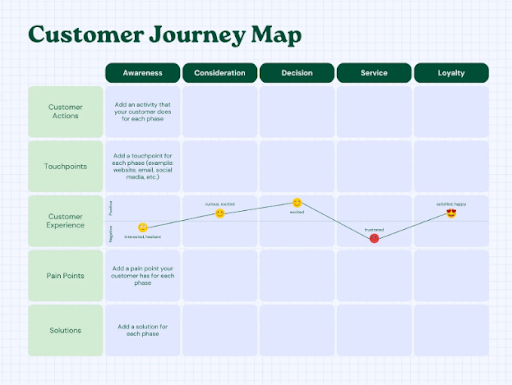Think of design thinking templates as problem-solving simplified! Picture having a blueprint set that transforms your thoughts into actuality, regardless of how outlandish they may be. Design thinking templates are specifically focused on that exact purpose. They function as enchanted maps that lead you through the labyrinth of creativity, assisting you in discovering optimal solutions for any obstacle. Read on as we delve into and explore how these templates can transform your most pioneering ideas into practical strategies.
What are Design Thinking Templates?
Design thinking templates are organized structures or presentations that aid individuals and teams in the design thinking process. They offer a structured method for solving problems by dividing intricate concepts into smaller steps. The templates generally consist of visual components, prompts, and inquiries that help users navigate through all phases of the design process, from problem comprehension to prototyping and testing solutions.
Consider design thinking templates as guides that direct you from identifying the problem (point A) to implementing a solution (point B) efficiently and creatively. They make brainstorming, idea generation, collaboration, and decision-making easier for individuals of all levels of expertise, thus increasing accessibility to the design process.
Design thinking templates offer a structured method for innovation, helping you unleash creativity and unlock new possibilities when facing a business challenge, developing a new product, or improving a service.
Benefits of Design Thinking Templates
The Design Thinking Process template functions as a kind of road map for coming up with original and practical solutions to issues. This is why it is quite beneficial:
- After conducting an in-depth investigation and comprehending their stories, it enables you to truly get to know the people you are attempting to assist.
- After examining all the data you have collected and developing profiles of the individuals you are attempting to assist, it assists you in determining the primary concerns.
- It promotes unconventional thinking, which helps you generate a wide range of solutions for the issues you have recognised.
- By creating basic versions of your ideas and evaluating their effectiveness, you get to test your ideas. This allows you to make changes and improvements before committing to a final solution.
- It is all about making things better over time. You keep trying out new ideas, getting feedback, and making improvements until you find the best solution possible.
Overall, the design thinking process template is like a readymade guide for problem-solving that helps you understand people’s needs, come up with great ideas, and make things easy and better step by step.
Popular Design Thinking Templates
Journey maps
Journey maps, as their name suggests, illustrate the user’s experience with a product or service, showing their actions, touchpoints, experiences, pain points, and solutions from start to finish. Researchers gather data through interviews or observations to understand the user’s awareness and considerations, then plot their journey along a timeline with stages or touchpoints. Summarily, these maps help teams gain insights, identify pain points, and find opportunities for improvement by highlighting areas of challenge or frustration.
Templates vary in format, but a typical example can be seen below.

Empathy Maps Template
Empathy map templates are structured tools divided into various quadrants, in no particular order- “See,” “Hear,” “Gain,” “Think,” “Say and Do,” and “Feel,” representing different aspects of the user’s experience. Each quadrant captures specific information about the user’s thoughts, feelings, actions, and needs, enabling teams to gain deeper insights into user needs and preferences.
Empathy map templates vary in format, but a typical example can be seen below.

https://www.canva.com/p/templates/EAFlKOBK7tM-empathy-map-mind-map/
Persona Templates
Creating personas is just like creating characters/ avatars like those in a storybook, but these characters represent different types of people who might use a product or service. These “personas” help teams understand who they are designing for and what those people need and want. To make a persona template, you gather information about real people who might use the product or service. Then, you organize their information into a template that describes the personas’ traits, like their age, job, and hobbies. Teams use these personas to guide their design decisions.
A typical example can be seen below.

Ideation Templates
Think of ideation templates like blueprints for coming up with new ideas. They are structured guides that help teams brainstorm and think creatively about solutions to problems. To use an ideation template, you gather a group of people and give them the template. Then, you follow the prompts in the template to brainstorm ideas. You might use techniques like drawing diagrams or writing down thoughts to generate lots of ideas. Templates vary in format, but a typical example can be seen below.


Prototyping Templates
Prototyping templates are like rough sketches of a product or service. They are simple versions that help teams visualize their ideas and test them out before making the final product. To create a prototype, you use a template to sketch out your idea. Then, you can test it with people to see if it works well and get feedback. Based on that feedback, you can make improvements. An example is shown below


